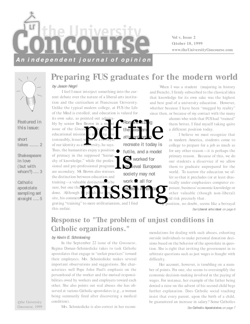A growing thirst for traditional liturgy
by Anthony T. Dragani
Does the Holy Spirit flee at the smell of incense or the sound of an organ? Do ritual gestures impede the working of the Holy Spirit? Are the charismatic gifts hampered by the rubrics of the institutional Church? For many years, on a subconscious level, I answered each of these questions in the affirmative.
As a child, my faith was very intimately linked to the Charismatic Renewal and the liturgical accompaniments often associated with it. My parents, quasi-converts from Evangelical Protestantism, had come into contact with the Catholic Church through charismatic friends, and had me baptized as a Roman Catholic. My parents never took the formal step of confirmation, as they perceived no need for it. With little understanding of sacramental theology, they felt free to dispense with it, as they had already been “baptized in the Holy Spirit.” For all intents and purposes, my parents were Protestants who chose to raise their son as a charismatic Catholic. The importance of Scripture and the charismatic gifts were heavily instilled in me, and form the bedrock of my spirituality to this day.
Growing up I served faithfully as a Eucharistic Minister, attended countless prayer services, and played electric bass guitar for the parish band. I even dated one of the liturgical dancers who performed regularly at Sunday Mass. I believed all of these things to be “Spirit-filled,” and saw traditional liturgy as something dead and stale. I would periodically drop by a more “traditional parish,” at which people sat lifelessly in the pews as an organist banged out theologically disoriented songs by Marty Haugan, David Haas and Michael Jonas: the “trinity” of contemporary Catholic music. That was a “traditional” Mass, as far as I knew, and it was awful. Other than the curiously mystical Byzantine Church that I had once visited as a child, these Oregon Catholic Press Masses were my only encounter with supposedly “high liturgy.” I was happier with my guitars.
And then the Spirit moved me in a new direction. I left the Catholic Church for a period of time, and became heavily involved with Campus Crusade for Christ. My parents were disappointed that I had left Catholicism, but were unable to produce a single reason for my remaining in the Church—other than “a word of knowledge” from the Spirit. This launched my family into an intense investigation of Church history, which ultimately led both my parents and me to fully embrace Catholicism. It was Church history that brought me back, and set the course for my spiritual future.
Suddenly I found myself drawn to the Catholicism of history. The Church Fathers became my everyday reading, and the soothing melodies of Gregorian chant my anthem. My mother and I developed a mutual obsession with Holy Icons, and began to crave the glorious “smells and bells” of the historic liturgy. After much soul searching I became a Byzantine-rite Catholic, and found myself magnetically drawn to truly ancient forms of worship. And to my pleasant surprise, God has been leading me to spiritual riches I never dreamed possible. In my own journey with God, the discovery of genuinely traditional liturgy has been the greatest of blessings.
I believe that the Holy Spirit is leading many in my generation to embrace traditional Catholic worship. I find Byzantine Catholic parishes all over the country teeming with young men and women drawn to melodious chant and religious artwork. This goes beyond a shallow externalism: these outward aids to worship actually lead them into a deeper communion with Jesus. Here at Franciscan University I have met numerous young people drawn to the Church’s liturgical past. I have also encountered the frustration with which they are burdened.
Every weekday scores of our students drive to St. Peter’s for Mass, and countless others arise before dawn in order to attend the 6:30 AM liturgy. On weekends a large contingent of the student population travel to Pittsburgh for traditional High Masses at Heinz Chapel or St. Paul’s Cathedral. While it is healthy and normal for students to visit other parishes, most of these students make the trip for a specific reason: they feel excluded by the liturgical style of Christ the King Chapel. They have expressed their longing for a change, but have been promptly accused of externalism or “resisting the Spirit.” Desiring a traditional style of worship, they must leave our campus community and go elsewhere.
We should not be surprised that this is happening. In the chaotic era following Vatican II, when confusion abounded as to how the council was to be implemented, Roman Catholics learned to despise the traditional liturgy. In many parishes “traditional worship” was equated with “dead worship,” and anything deemed ritualistic was ruthlessly abolished. Previous hallmarks of Catholic worship, such as chant, incense and the organ all but vanished. Franciscan University, too, underwent this process, associating high liturgy with spiritual apathy. A contemporary “praise and worship” style became the dominant trend, as it proved to be effective in evangelizing the student body. But like in any time of revolutionary change, what was despised by one generation is revered by the next.
My generation, “Generation X,” as we are sometimes called, is tired of drifting along without a sure foundation. We are looking for roots. Raised in a society with no sense of historical or cultural identity, we crave a connection to the past. This is what has driven many of us, myself included, to embrace the Catholic Church. After giving intellectual assent to the truth of Catholicism, we look for historical continuity and cultural wealth in our worship. We not only wish to believe like the Catholics of history, but we also long to worship like them. Unfortunately, it is very hard to find a Roman Catholic parish in which this is possible. Many parishes rely exclusively on guitars, while those that do have an organ play songs written in the 1980s. This does not satisfy us. We need to feel as if we belong to something that pre-dates the cultural revolution of the sixties.
This is why so many students leave campus for Mass, or attend the quiet and austere 6:30 AM service. They are tired of being reminded that the Church is undergoing a process of tumultuous change. Constantly hearing guitars playing music written within the last two decades serves as a painful reminder that the Church of today is disassociated from its past. Instead, it is comforting for many students to hear the historical music of the Church, and perhaps get a whiff of incense, imagining that the Church of today is essentially the same as it was yesterday. We want to be reminded that the Church has a glorious liturgical legacy, which is our birthright as Catholics.
What is to be done? I certainly would not propose eliminating the contemporary Masses, as this spirituality can be very valuable to many. But why not have a balance, offering one Mass a day accompanied by classical organ music and chant? There is currently a petition circulating to this effect.
We must sincerely consider the possibility that the Holy Spirit is calling us to draw from the liturgical riches of the Church’s past. Is it possible that God is calling the Church to move in this direction? Unfortunately, the sad reality remains that an ever-growing proportion of our student body must leave campus in order to follow this prompting. Perhaps we as a Catholic university have a duty to share the gems of the past with our students, who may not encounter them elsewhere.
Mr. Dragani studies in the MA Theology Program at FUS.


